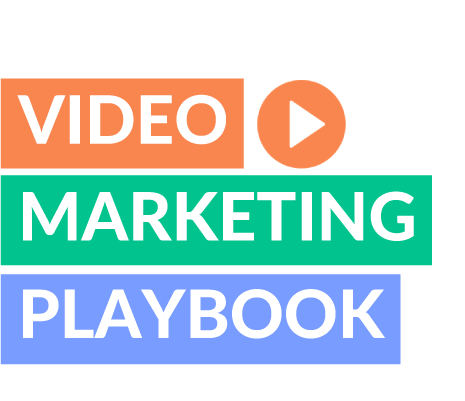
Thank you for checking out The Tech Company’s Video Marketing Playbook. If you prefer a PDF, click here to download. Be sure to bookmark this page.
Video Outranks Everything.
Love it or hate it, video marketing has made its place in the marketing world, and the role of video is only going to grow in the coming years. In fact, 53% of consumers would like to see more video content in the future. For up-and-coming young adults between the ages of 18 and 24, this number is 65%. These numbers mean video marketing outranks blog posts, photos, infographics, long-form articles, and even downloadable guides like this one. (And yes, we use videos in our marketing too.)
For tech companies whose products may be highly sophisticated and potentially complicated for a layperson to comprehend, video is even more critical. Video allows you to make complex topics easy to understand without being condescending, bringing in buyers ranging from overwhelmed beginners to industry experts.
If you’re part of a tech company that wants to learn how to use video more effectively in your marketing, this guide is for you. We’ll tackle several different kinds of videos, why they matter, and how to use them effectively. Some ideas might be familiar. Some might surprise you. At Nickel City Graphics LLC, online video is what we do, and we want you to have all the information you need to step confidently into the world of video marketing.


The Overview Video
Product 101
The overview video is basically Your Product 101. This video is your chance to draw in new customers who may not be entirely clear about what it is that you have to offer. Because it’s an introduction to your product, it’s important to keep this video quite brief; the folks who want the nitty-gritty details will stick around for another video that explains them in more depth.
The overview video ensures that you and your shopper are at least a cursory match when it comes to what they’re looking for. It covers broad themes like:
- What is this product?
- What does it do?
- What does it look like?
- Who uses this product?
These are critical topics to address upfront. You’ll see unhappy reviews of almost any online retailer complaining that the product was smaller, more complicated, or less compatible than what the buyer had assumed.
Whatever you’re thinking is too obvious to address in an overview video, it probably isn’t. If it’s a camera, state that it’s a camera. By mentioning it in passing, you can get the fact across quickly without being patronizing or belaboring the point.
First impressions matter.
Because the overview video is often a potential customer’s first introduction to your product, it’s especially important that this video, out of all the marketing videos you create, has a high production value. Unless you were a videographer in a past career, this means hiring a professional. There are videos out there on the internet that contain content so meaningful or engaging that people don’t care about the poor lighting, echoing, off-sync audio, cluttered backgrounds, or awkward editing. This is not that video. You don’t get a second shot at making a first impression, so make sure that yours is professional, on-brand, and accurately reflects your company’s vision.
Overview Video Example
The first video we produced for ACV Auctions was an overview video. It was an intro to the software, a new kind of wholesale auto auction and how it all worked. The production featured co-founder, Joe Neiman, a fast car and screenshots of the app in action. To date, this video has racked up over 126,000 views.


Feature/Benefit Videos
Remember those detail-obsessed customers mentioned in the overview video section? This is where you make their day. Feature videos are where you explain and demonstrate key reasons someone would want to use your product. These reasons can include things like:
- Physical or mechanical features
- Capabilities
- Ease of use
- Customizability
- Compatibility with other products
- Warrantees or other guarantees
- Compliance with customer industry regulations
- Environmental friendliness
- Aesthetics
If this list looks incredibly varied (and potentially endless), that’s because it is. What’s more, a feature for the right customer is a bug for the wrong one. While you may want a more comprehensive overview video, it also makes sense to create short videos, each detailing a specific benefit, rather than one long one. If you’re trying to sell “Streamlined, works out of the box, and designed so it’s virtually impossible to screw things up,” one moment, and “Endlessly customizable, set it up how you like and tweak it to your unique circumstances as you go” the next, you’re going to have some confused messaging.
Feature videos and SEO.
Another reason for creating a series of separate videos that focus on individual features is the search engine optimization value. People are looking for solutions that fit their specific needs and search online accordingly. So while they might not search for “features of ABC fitness app” (especially if they’ve never heard of your app before!), they might be searching for “fitness app with a search function” or “fitness app with customizable alerts.” While the search function might be only a small part of what makes your product unique, a 30-second video demonstrating how it works will pop up right away and can then drive customers to more information, while a longer, more comprehensive list of features might not even get noticed by this particular customer.
Features and differentiation.
Keep in mind that features and benefits are not precisely the same thing as differentiation. Some of your product’s features may be exactly the same as similar products that you or your competitors make, and that’s fine. Some feature or benefit videos should highlight those differences, however.
Even if the difference seems neural rather than explicitly positive, many people will have a preference. Make sure you preemptively answer the question “Why this product over all others?” Don’t wait for your customer to ask, show them.
The format of a feature video.
A feature video doesn’t need to be long or complicated. It’s merely a demonstration or explanation of a critical feature or benefits of your product. Keep it targeted, rather than exhaustive. It’s much easier to get an interested customer who is hungry for more information to watch an additional video than it is to regain a person’s attention once you’ve lost it by spending too much time on information that doesn’t apply to them. By linking these brief videos together with an embedded call to action, you create interaction with your materials and a natural desire to learn more.
Feature/Benefit Video Example
I know this is a tech company guide, but our most recent project involving a feature video is a campaign for the VIP tickets arm of the amphitheater concert venue at Darien Lake, NY. The example to the right is one of ten feature/benefit video to be produced for the venue. In their own words, a few concert-goers describe the benefits of VIP parking.


Testimonial Videos
Testimonials and social proof have long been understood to be a critical part of marketing, and that’s not going away. Half of people under 50 say they almost never purchase something for the first time without checking out online reviews first. Still, the old “we’ll just wait for reviews on Yelp/Google/Facebook doesn’t cut it in today’s cynical world. With more and more companies buying or faking reviews, (remember the guy who managed to get his shed listed as the top restaurant in London?), the average online buyer is more skeptical than ever.
The Hierarchy of Testimonials:
At the bottom: anonymous testimonials or reviews. These are obviously the easiest for potential customers to disregard, but they still have an impact in mass quantities. One 5 star review on Amazon is virtually meaningless, but 300 of them means something. Still, savvy shoppers won’t be too heavily impacted by reviews like this and will dig down for opposing views. Given people’s limited attention spans, you probably won’t want to clutter your own website with low-impact testimonials like this.
Barely better: add a full name or institution. People who can be identified by their names are a bit more reliable than reviews by users named things like “CoffeeBro82”, but “Jane Johnson” isn’t that much better. There are exceptions to this: If Jane Johnson is a celebrity, industry expert, or influential figure in your field (or the field many of your customers belong to), the name is worth pursuing. Alternatively, if Jane Johnson isn’t a big deal at all, but the company she works for is, adding that piece of information can add instant clout to her testimonial.
We promise this is a real human being: include a photo. Adding a photo of Jane with her testimonial isn’t necessarily that much more difficult than merely stating her name, but it packs more psychological punch regardless. Someone who is willing to put their face with their words clearly believes in the product. Better than formal headshots (which could easily pass for stock photos in many cases) are photos of the people actually using your product.
Top of the line: video testimonials. Video testimonials offer the greatest immediacy and personal connection, letting potential buyers look right in the face of a satisfied customer and hear their unique voice. So long as the video is not overly scripted (the first inclination of many people who harbor a secret dread of public speaking), it feels more genuine than a tidy paragraph, like a conversation between one consumer and another.
The importance of video testimonials for tech companies.
A list of technical specs can undoubtedly impress an engineer, but more often than not, the actual purchasing decisions at a business (or at least the ultimate sign-off) are up to a non-technical individual who needs to be convinced. This can even be true for tech products designed for personal use, which are frequently holiday gifts. Video testimonials are a way to bring the human element into your marketing. No matter someone’s technical chops or lack thereof, everybody understands what a person looks like when they’re talking about something they really love.
What does a great testimonial video look like?
A great testimonial video is the individual sharing of a delighted customer. Most everything else is up for grabs. They can be as short as 15-30 seconds, as with someone sharing how your product helped them complete an important project on time. This kind of video is perfect for social media. They can be much longer, with someone actually demonstrating how they tweaked the product for their own circumstances and showing the results they got, which can increase engagement on your website. They can be an edited-together string of shorter clips from longer testimonials, which can be great for demonstrating the diversity of uses your product has. The only mandatory parts are enthusiasm and specificity. The rest is up to you, your brand, and your customers.
Testimonial Video Example
For the testimonial video example, we are featuring Pointman, a productivity, scheduling, tracking app for contractors. This testimonial features the owner of T-Mark Plumbing Heating and Cooling.


Employee Bio Videos
This type of video is hugely underutilized, which means you have the chance to stand out without doing anything too out-of-the-box. Here’s what the typical employee bio looks like in written form:
- The employee’s name and role.
- A bit about their training and background, including their tenure at your company.
- A personal tidbit or two, like their hometown or hobby.
- A photo of the person smiling into the camera.
In a larger business, these are usually written in the third person (“Erika Wu graduated from the University of New Mexico in 1997 …”) and tend to follow a similar formula for most employees. They’re nice enough and can be handy tools for networking, but they’re not particularly exciting.
This situation is where a video bio can come in. Video bios give potential customers, job applicants, and key community members a chance to connect with your leadership team in a way that they wouldn’t otherwise. Tech can feel like an impersonal field at times. Brief video introductions offer the chance for company leaders to share not just their job qualifications, but their values, communication style, and personality.
How to use employee bios.
The value of a bio video isn’t limited to its content. In fact, the primary benefit of bio videos is not what they might contain, but how they might be used. Some possibilities include:
- Posting the videos on social media. Since videos are shared considerably more often than links, bios that take the form of a narrative about getting into the field, joining the company, and growing in their role can double as fascinating content, especially to young people who are early in their careers.
- Sharing videos with job candidates before an interview. Seeing a video of the people, they’ll be interacting with can help put applicants at ease, allowing you to get a better sense of their ability to succeed in the job.
- Including links to the bios in news releases. Links allows journalists to get a better sense of the leading players and help them decide who to interview.
- Embed the videos in relevant blog posts or web pages. If you’re celebrating someone’s recent accomplishment or anniversary, explaining a particular team or department, or announcing a new venture, bio videos of the people involved are a ready-made bit of media that can engage website visitors in a new way and encourage them to discover more about who you are and what you do.
While product videos need to be made new with each major update, bio videos can be evergreen, remaining relevant for several years at a time. Evergreen content means you always have an exciting source of video content on hand that can be used to add interest to your blog, social media accounts, or website during a time crunch.
Employee Bio Video Example
We will go back to the ACV Auctions well for the employee bio video example. We recently started capturing employee bios as part of our shoots for ACV Auctions. The benefits of these videos are two-fold. ACV Auctions is hiring like crazy, so first these videos act as ‘great place to work’ endorsement videos while giving a glimpse into the day of an ACV Auctions territory. Second, these videos provide much-needed content to the marketing department at ACV Auctions. They acknowledge their employees and boost brand awareness when they use these videos in their marketing.


Internal Training Videos
Yes, this guide is about using videos for marketing, and training doesn’t typically fall under that category in the org chart. Still, marketing is about building enthusiasm for your products and your brand, and nobody needs to get that message more than your employees. Video enables you to provide training that is consistent and accessible at any time.
Flipped learning and today’s workplace.
Before video was a significant part of our lives, you had a limited number of options for training employees. You could gather them together and lecture. You could explain things to them one-on-one. You could put the information into a manual and ask them to study it. Or you could try some combination of these. When video became more common, this became a favorite way to provide training, especially to brand-new employees. While the training videos of years past now look incredibly cheesy, they certainly served their purpose. In fact, even the K-12 sector has found video to be an effective method for education and training.
“Flipped learning” is a hybrid approach in which the lecture or demonstration part of a lesson is provided to individuals in the form of a video. This approach frees up the teacher or trainer to spend their limited time discussing the implications of what is addressed, answering questions, and clearing up misconceptions, rather than providing the content itself. Since videos can be repeated, slowed down, and saved for future reference, they’re more useful than in-person explanations at times. Combine videos with quick online assessments, and you can quickly discern what areas an employee needs to gain clarity on through a conversation. Use the same assessments to see at a glance what material was clearly and effectively presented, and where your training videos need to be improved.
Using videos for training new employees.
Specific areas of training are needed by all employees, regardless of their role or experience. This is the perfect place to start creating training videos since they’ll be used by the largest number of individuals. Examples of this type of video might cover topics like:
- Company mission, vision, and values.
- General policies and procedures.
- Safety procedures.
- Grievance policies.
- Accessing benefits.
- Organizational structure.
- The company’s history.
If you have a large number of employees in a similar job (especially one with higher turnover, such as call center employees), it may also make sense to create training videos regarding the specific tasks they’ll be expected to perform in their role. This also provides something that a supervisor can easily reference with a struggling employee as well.
Using videos for training experienced employees.
While introductory videos are more common for the reasons mentioned, this isn’t the only time during an employee’s tenure during which they can benefit from video training. Other possibilities include:
- Videos aimed at staff who are being promoted to management for the first time, helping them learn to delegate, encourage, and communicate effectively.
- Videos explaining the new company structure after layoffs, extreme growth, or other reorganization.
- Videos to help employees learn about the work of other teams or departments to foster closer collaboration.
- Videos designed to help high achieving employees earn new certifications or other credentials.
Also, creating training videos can itself be used as a learning activity, as top employees work to develop the skills to communicate some aspect of their work clearly to others.
Training videos give remote employees access to top-quality training.
Today’s workforce is increasingly spread out around the world, which means that training on things like company policies and culture, which might have been shared informally over the water cooler in the past, is especially critical. Maintaining and growing a library of training videos allow remote employees to access the information they need when they need it, regardless of what time zone they are in.
Training Video Example
Produced for ShoptoCook, a company implementing marketing campaigns for independent grocery retailers that reach in-store, on the web and to mobile devices. This video features ShoptoCook’s in-store kiosk, a touch-screen computer system that offers coupons, recipes and other information.


Next Steps
You’ve seen how important it is to include video in your marketing strategy, and you’ve seen some of the many ways this can be done. Maybe you’ve got a few ideas for new videos bubbling away. So what happens next? That depends on what you’re feeling like as you read this.
Need concrete examples? Watch some of the example videos in our portfolio or see how all of the video types discussed in this guide fit into one coherent strategy in a case study about a tech company like you.
Are you looking for more information about video marketing in general? Visit our blog, which is full of practical tips and useful information.
Have questions? Want to set up a consultation? Nickel City Graphics is here for you. Get in touch today.


